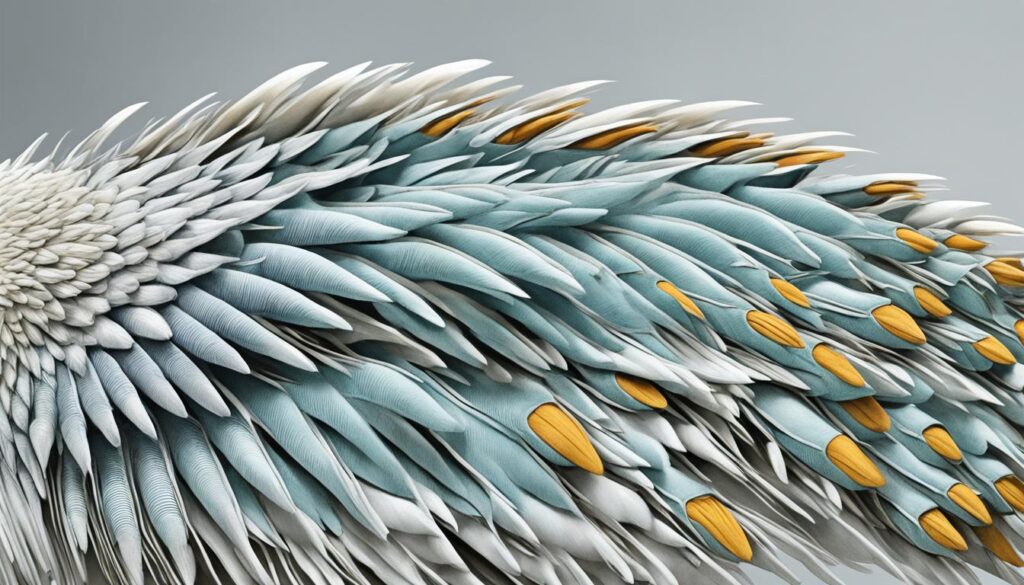Most birds are digitigrade animals. This means they walk on their toes, not their whole feet. Their foot anatomy is amazing. It lets them do lots of things, like walk, build nests, and eat.
The skeleton and feet of birds are special. They are made for flying. Birds have bones that are fused together. These bones, like the tarsometatarsus and tibiotarsus, add to their ability to fly. Furthermore, a fused spine called the synsacrum helps birds stay stable and strong.
Key Takeaways
- Most birds are digitigrade, walking on their toes rather than the entire foot.
- Avian feet exhibit a diverse range of adaptations, including fused bones and specialized toe arrangements.
- The tarsometatarsus and tibiotarsus are crucial structural elements that contribute to the birds’ flight capabilities.
- The pelvic girdle and synsacrum provide stability and strength to the avian skeletal system.
- Avian feet serve multiple functions, from locomotion to reproduction and thermoregulation.
Introduction to Avian Feet
The anatomy of avian feet is very diverse. It shows how important these parts are for birds. Most birds walk on their toes, not the whole foot, a trait called digitigrade. The bones at the bottom of their feet combine to make the tarsometatarsus. The upper foot bones and the tibia are linked to form the tibiotarsus. Birds also have a strong pelvic girdle that joins to a single spinal bone, the synsacrum.
Importance of Bird Feet Anatomy
Understanding bird feet helps us see how birds have adapted to many roles. These include activities like walking, perching, and feeding. Studying the anatomy of avian feet shows us their history, environment, and habits.
Overview of Foot Structures and Functions
- The tarsometatarsus and tibiotarsus are crucial for avian foot movement and specialized jobs.
- The ankle and knee joints offer fine control and skill for tasks like holding, perching, and moving things.
- Types of phalanges (toes), like anisodactyl and zygodactyl, mean feet are suited for different work, from hunting to climbing.
- Different foot types, like webbed, lobed, and raptorial, help birds live in water, on land, or hunt, respectively.
Learning about the anatomy of avian feet gives us clues to birds’ adaptations and homes. This knowledge deepens our wonder and understanding of birds’ variety.
Digitigrade Locomotion
Most birds are classified as digitigrade animals. This means they walk on their toes mainly. They do not put their entire bird feet down. The distal phalanges and metatarsals of bird feet anatomy form the tarsometatarsus. The upper bones combine with the tibia to make the tibiotarsus.
Tarsometatarsus and Tibiotarsus
The tarsometatarsus is key for birds. It connects the toes to the main foot, aiding in digitigrade locomotion. The tibiotarsus stabilizes the knee with a strong structure. These features let birds move efficiently and with balance.
Ankle and Knee Joints
The bird knee joint is forward-facing and often covered by feathers. It’s between the femur and tibiotarsus. The “ankle” or ankle joint faces backward. It connects the tibiotarsus to the tarsometatarsus. This design helps birds stand on their toes. It also gives them the flexibility for various activities.
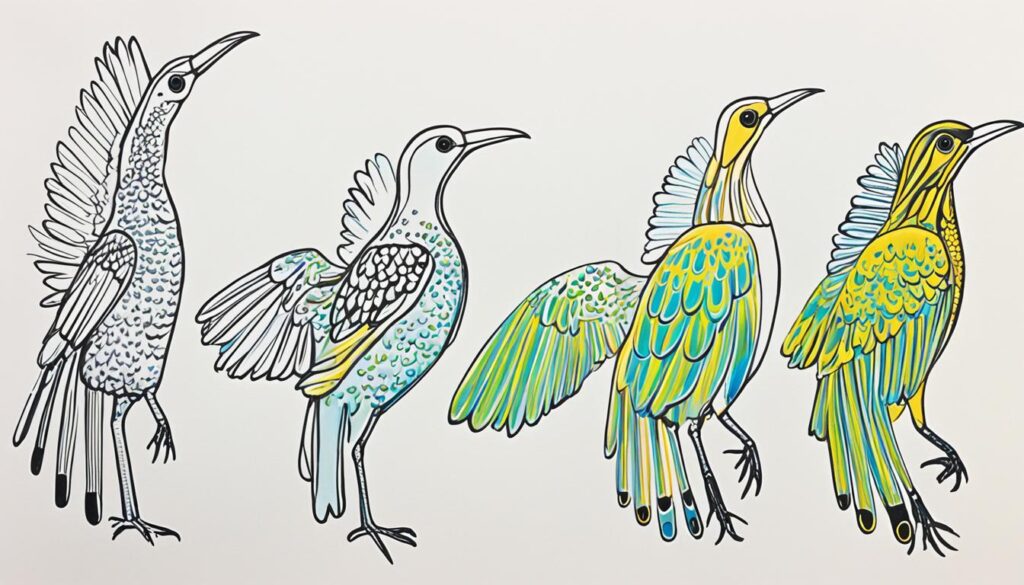
“The backward-pointing ‘heel’ that is easily visible is a joint between the tibiotarsus and tarsometatarsus.”
Toes and Unfused Metatarsals
The bird’s foot shows amazing steps in evolution. Most birds have four toes aiding in many ways. Three toes point towards the front and one towards the back. This setup helps birds with balance and movement.
Each toe is equipped with a claw made of tough keratin. These claws are essential for tasks like hunting, perching, and even romance. They are key tools for life.
What makes bird feet stand out is the unfused metatarsals. This special design gives birds great control and flexibility. It supports activities from walking to swimming.
“The avian foot is a marvel of evolutionary engineering, with its intricate arrangement of toes and unfused metatarsals enabling birds to thrive in a vast array of environments and engage in a remarkable diversity of behaviors.”
Studying how bird feet are built reveals their unique abilities. These specializations helped birds rule the skies. They are among Earth’s most varied and successful creatures.
Pelvic Girdle and Synsacrum
Birds have a unique skeletal structure for their legs. This structure is called the pelvic girdle. It’s strong and connected to the spine by the synsacrum. This fusion gives birds a solid base.
Rigidity and Reduction of Mass
Birds have very light but strong bones for flight. Their bones are fused into a rigid structure with many air pockets. These air pockets connect to their breathing system, reducing weight and increasing flight efficiency.
- Large gliding and soaring birds tend to have the highest number of hollow bones in their skeletal system, aiding in flight.
- Diving birds typically have less pneumatized bones compared to non-diving species.
- Flightless birds such as ostriches and emus have pneumatized femurs for lighter weight.
- Penguins, loons, and puffins lack pneumatized bones entirely.
The avian pelvic girdle and synsacrum are key. They make bird legs both strong and light. This lets birds do many things. They can walk, run, and most importantly, fly.
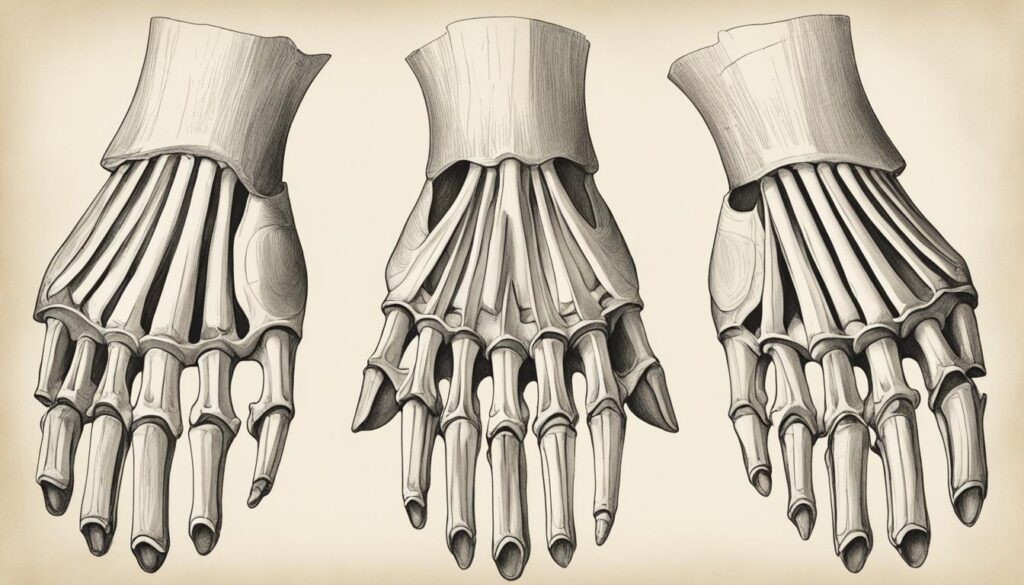
“Birds’ skeleton is incredibly lightweight, yet incredibly strong – a true engineering marvel of nature.”
The way the avian skeleton is built is amazing. It’s both very strong and very light. This helps birds live in many places, from the air to the ground, adapting to different environments.
Plantigrade Locomotion
Most birds walk on their toes in a style called digitigrade locomotion. But, loons and grebes are different. They are great at swimming and have a special way of moving called plantigrade locomotion. This helps them move well in the water.
Loons and grebes have shorter thigh bones and narrower pelvis compared to many birds. Their legs are made for swimming more than walking. Their feet are positioned in the back of their body. This helps them swim effectively, but they find it hard to walk on land.
Loons and grebes use their unique feet to swim fast. They push themselves through the water with strong leg kicks. This is similar to how we move when swimming. Their special body shape makes them very good at catching fish in the water.
Yet, walking on land isn’t easy for them. Their bodies are better for swimming than walking. So, loons and grebes often shuffle or waddle when they are not in the water.
Loons and grebes’ way of moving is a great example of how birds can change to live in different places. Their unique feet show us just how much birds can adapt. This helps them live in many different areas.
Diverse Functions of Avian Feet
Bird feet are amazing tools that help birds survive and live their lives. They’re key for moving, eating, and reproducing. The detailed design of avian feet shows how birds have changed to fit different environments.
Locomotion
The bird feet structure is key for how a bird gets around. It lets birds do many things, like walk, climb, and swim, with ease. The avian extremities carry the bird’s weight and help with balance during motion.
Flight-related Functions
Even a bird’s feet anatomy helps it fly. The avian phalanges work like engines for takeoff, giving the push birds need to fly. They also soften landings, acting as cushions.
Feeding and Related Activities
The bird digit morphology is perfect for feeding. Birds use their avian pedal appendages to catch food, handle it, and find more. These tasks are vital for a bird’s diet.
Reproduction and Nesting
Birds’ feet are also crucial for making nests and raising young. They’re used to care for eggs and help in mating. They keep eggs warm and safe while nesting.
This shows just how adaptable what are birds feet called are. Their design helps birds live in many places, from the air to the water and land.
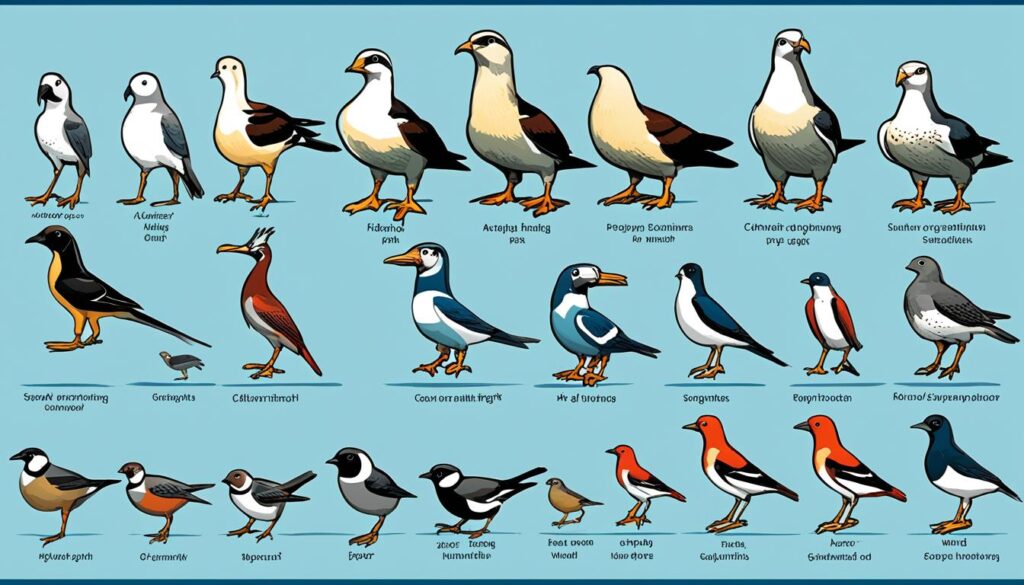
what are birds feet called
Birds have complex feet with special names for each part. The toes or digits and tarsometatarsus are crucial. The structure includes the distals and metatarsals. The hallux is similar to a human big toe.
Birds are digitigrade, which means they use their toes for walking. Their “knee” is really their ankle. The joint above is their true knee.
Avian Foot Structures and Functions
Each part of a bird’s foot has a special job, such as:
- They help birds move, perch, walk, hop, and climb.
- Birds use their feet to eat, handle food, and find meals.
- Feet are vital for nest building, egg incubation, and raising young.
- Foot structure aids in flight, helping birds balance and land safely.
This knowledge is key for bird lovers and scientists. It sheds light on how birds adapt and behave.
| Avian Foot Structure | Description |
|---|---|
| Toes (Digits) | The key part of a bird’s foot, essential for moving and staying balanced. |
| Tarsometatarsus | A support system made of foot bones that keep birds stable. |
| Hallux | This first digit is used for grabbing and perching, like our big toe. |
| Ankle Joint | Though it looks like a knee, this joint bends backward and is an ankle. |
| Knee Joint | The true knee of a bird, which supports its leg higher than the ankle. |
Knowing about bird feet helps us marvel at their survival skills and unique abilities.
Toe Arrangements
The structures and functions of avian feet show birds’ adaptability. Three main toe patterns are seen: anisodactyl, zygodactyl, and some rare arrangements.
Anisodactyl: The Most Common Toe Arrangement
Most birds, around 60%, have anisodactyl toes. This means three toes point forward (digits 2, 3, and 4) and one points back (digit 1). It helps birds grip and perch well.
Zygodactyl: Adapting to Specialized Needs
Approximately 23% of birds have zygodactyl feet. Here, two toes face forward (digits 2 and 3), and two face backward (digits 1 and 4). This design aids in climbing and catching prey.
Exploring Other Toe Arrangements
Besides anisodactyl and zygodactyl, birds have unique toe setups for different needs and environments. Some include:
- Syndactyl: Two front toes are partly fused, found in about 10%.
- Pamprodactyl: All four toes face forward, seen in approximately 5% of birds.
- Heterodactyl: With two forward-pointing (digits 3 and 4) and two backward-pointing toes (digits 1 and 2), this is found in roughly 2% of birds.
- Tridactyl: Only three toes are found in a few bird species.
- Didactyl: Ostriches have just two toes, making them the only species with this feature.
These foot structures show birds’ diverse adaptations to their surroundings and behaviors.
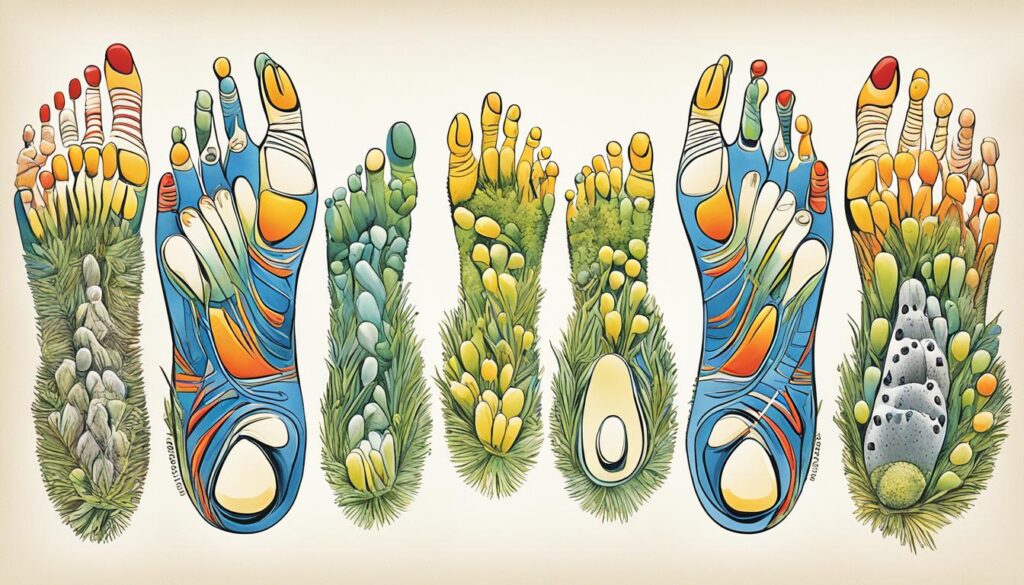
“The diversity of bird feet is a testament to the evolutionary ingenuity that has allowed these remarkable creatures to thrive in a wide range of habitats and fulfill a variety of ecological roles.”
Learning about bird feet details enhances our view of nature and the adaptations in the bird world.
Webbed and Specialized Feet
In the world of avian feet, certain birds have evolved to fit their specific needs. Webbed and lobed feet are amazing examples of how nature designs for function and survival.
Palmate and Totipalmate Feet
Aquatic birds like ducks, geese, and cormorants boast perfect feet for water life. Their webbed, or palmate, feet help them glide through water efficiently. Cormorants take this further with totipalmate feet. Here, webbing covers all four toes, giving them a swimming edge.
Lobed Feet
Grebes and a few other waterfowl have lobed feet. These feet have skin lobes that open while swimming, making paddling more effective. As they move forward, the lobes draw back, reducing water drag.
Semipalmate Feet
Not every water bird has fully webbed feet. Plovers and herons, for example, have semipalmate feet. This means they have webbing between some of their front toes, aiding in support while they forage and wade in shallow waters.
The variety in avian feet illustrates how birds adapt to different zones. Be it open waters or shorelines, specialized feet help birds move effectively and find food. This shows the power of evolution’s creativity in nature.
Raptors and Their Talons
Raptors are fierce birds known for their strong avian feet and sharp talons. These talons help them catch and kill their food. The way their feet are built is a cool part of studying birds.
Raptors have big, powerful talons. A key talon for them is the one on the second digit, which is as big as the one on the third. The first digit’s talon is even larger and is great at reaching deep.
Each kind of raptor has talons designed for their unique hunting styles. Those that hunt birds have long toes and a big third digit with needle-like talons. But ones that eat snakes have short, strong toes. They use them to break the snake’s back and avoid getting bit.
Raptors that eat fish, like Ospreys, have big, curved talons. This helps them catch slippery fish. Raptor species that go for bigger prey have specially strong talons. These talons are on digits 1 and 2 to deliver fatal blows, with the back talon used for deep stabs.
| Raptor Type | Talon Features | Prey Specialization |
|---|---|---|
| Bird-hunting Raptors | Long, slim toes with a very long third digit and medium-sized needle-like talons | Birds |
| Snake-hunting Raptors | Short, thick, strong toes to crush the snake’s spine; legs covered in thick scales | Snakes |
| Fish-hunting Raptors | All four talons being about the same size and shape, very large and highly curved | Fish |
| Large Prey-killing Raptors | Hypertrophied talons on digits 1 and 2 to immobilize and deliver fatal wounds; the hind talon is crucial for deep stabs | Large prey |
| Scavenger Raptors | Big feet to provide a large base for lateral pull at a carcass; can lift over 30 kg dead weight with their necks and legs | Carrion |
| Nocturnal Hunting Owls | Short, robust toes with relatively long talons for maximum leverage to secure small prey efficiently | Small prey |
Raptors come in many forms, each with talons for their special jobs. Whether for seizing birds or grabbing fish, their amazing feet show the beauty and diversity of nature.
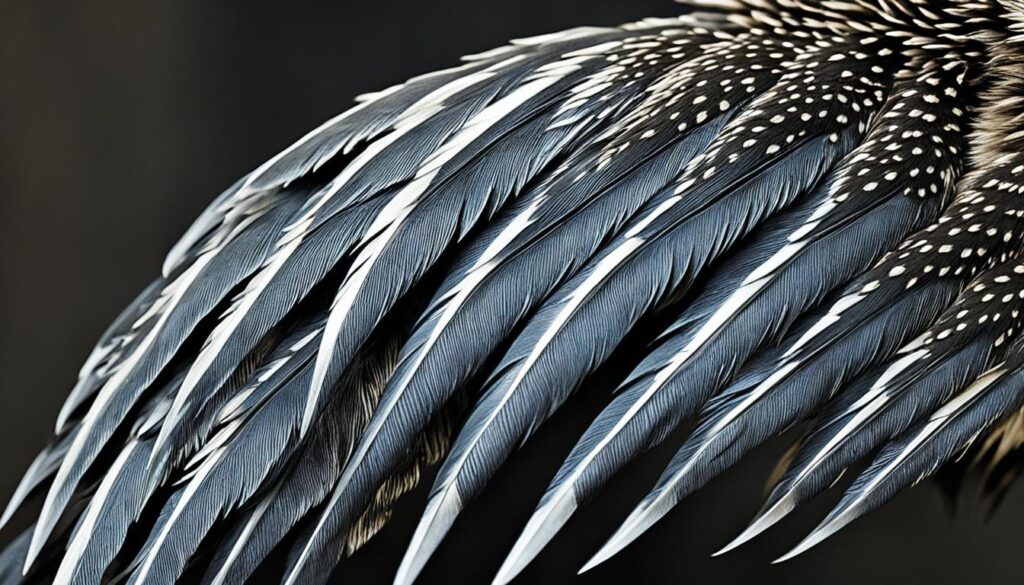
“The talon on the first digit (hallux) of raptors is typically larger than the three forward-facing talons and has the largest muscles dedicated to that one toe, enabling it to stab the deepest.”
Perching Mechanisms
A bird’s feet are designed for comfortable perching. When a songbird lands, its ankles flex. This action activates tendons, pulling the toes around the perch.
Once landed, the toes stay closed until the bird leaves. Then, research shows 100% of birds rely on perching to rest and sleep. How often they perch depends on their foot design and bird type.
Birds with feet for grasping and perching have different bones and tendons. Surprisingly, injuries from perching are less common than from other actions.
| Bird Type | Perching Foot Adaptation | Perching Behavior Frequency |
|---|---|---|
| Small Passerines | Specialized for gripping smooth branches | Frequent |
| Birds of Prey | Adapted for grasping and stability on rough surfaces | Occasional |
| Waterfowl | Webbed feet for swimming, less adapted for perching | Infrequent |
How well a bird can grip is key to its life. Data on grip in different bird species varies by their size and what they do. Birds of prey and small songbirds have adapted grips for their specific needs.
The way birds perch is also key in attracting mates. Studies show a link between foot shape, flight, and finding a partner.
“The intricate design of a bird’s feet allows them to perch comfortably for extended periods, with the ankles and tendons working together to maintain a secure grip on the perch.”
Adaptations to Different Environments
The diversity in bird feet shows how well birds adapt. Different birds have feet that fit their habitats perfectly. For example, on land, birds like grouse and ptarmigan have special foot features to help them live on snow.
Terrestrial Birds
Grouse and ptarmigan live in snowy areas. They have fringes on their avian feet that work like snowshoes. These fringes, called pectinate toes, make their feet wider. This keeps them from sinking into soft snow.
Aquatic Birds
In water, birds like grebes and loons are built for swimming. Their legs are placed far back, great for water but not for land. Birds that dive, like ducks and cormorants, have webbed or lobed feet. This helps them swim fast.
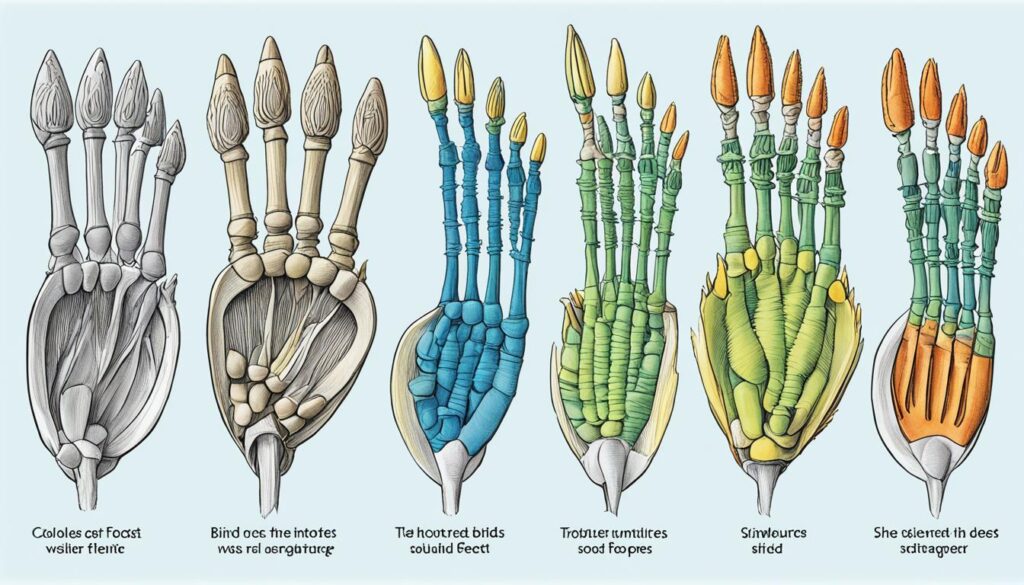
Birds’ feet are special. They help birds live and do things in their habitats. This includes how they eat, make homes, and attract mates.
“The diversity of bird digit morphology shows birds’ amazing ability to adapt.”
From hunting birds with strong talons to shorebirds that probe for food, bird feet are wonderfully suited to their lives. Each bird type has evolved feet that are just right for them.
Evolutionary Significance
The various kinds of avian feet show how birds have evolved over time. These foot adaptations let them live in many different places, like in trees, water, or while hunting. This shows the amazing ways birds have found to fit into their environments.
The way bird feet look and are built speaks to how versatile birds are. More than half of all birds have feet that are perfect for where they live and how they catch food. This makes the variety of bird feet really interesting.
For example, birds that hunt have sharp, curved claws. These claws help them catch prey. But birds that perch have feet made to grip branches. This kind of foot, called anisodactyl, is very common among perching birds.
| Foot Adaptation | Percentage of Bird Species |
|---|---|
| Grasping Feet (Anisodactyl) | 55% |
| Webbed Feet (Palmate) | 12% |
| Zygodactyl Feet | 8% |
| Specialized Feet (Lobed, Semipalmate) | 25% |
The evolution of bird feet is a truly incredible journey. It has shaped the vast range of birds we now observe. Whether it’s the talons of predators or the webbed feet of swimmers, each type is perfect for the bird’s lifestyle.
“The evolution of avian feet is a testament to the remarkable adaptability of birds, allowing them to thrive in a wide range of environments.”
Studying what birds’ feet are called and what they do helps us understand bird evolution. It shows us how the bird kingdom’s wide diversity came to be.
Conclusion
The feet of birds are incredible structures. They have evolved for a wide range of uses. They include what are birds feet called and their structure, to anatomy. Understanding the unique features of bird feet gives us insights into the amazing diversity and success of birds.
Birds have different types of feet for various functions. Raptors have special feet for catching prey. Aquatic birds, on the other hand, have webbed or lobed feet for swimming. These different types of bird feet continue to amaze us. They help us learn more about nature.
Birds’ feet show amazing versatility and strength. By looking at bird feet names and their anatomy, we see both beauty and complexity. This study helps us understand evolution. It shows how the natural world has developed the wide range of birds we see today.
FAQ
What are the main parts of a bird’s foot?
A bird’s foot has toes, or digits, and the tarsometatarsus. This is a fused part made of the distals and metatarsals.
How do birds walk and perch?
Most birds walk on their toes, like digitigrades. They don’t use their whole foot. When a bird perches, its ankles move, making its toes grasp the perch. This lets the bird sit comfortably there for a long time.
What are the different toe arrangements found in birds?
There are various toe patterns in bird species. The anisodactyl type, with three forward toes (2, 3, 4) and one back toe (1), is the most common. Another, the zygodactyl type, has two forward toes (2, 3) and two back toes (1, 4).
There are also the less usual heterodactyl and tridactyl arrangements out there.
What types of specialized feet do aquatic birds have?
Aquatic birds’ feet are adapted for swimming. Ducks and geese have webbed feet. Cormorants have totipalmate feet. Grebes and some waterfowl have lobed feet.
These types of feet help them move in the water.
How do raptors use their feet?
Raptors, like hawks and owls, have strong feet and sharp talons for hunting. Hawks might have long legs to carry prey. Peregrine falcons use their big feet to punch flying prey.
How have bird feet evolved to adapt to different environments?
Birds’ feet have evolved to match their surroundings. Terrestrial birds, like grouse, have fringes on their toes for snow-walking. Aquatic birds have their feet at the back, perfect for swimming but not walking.
